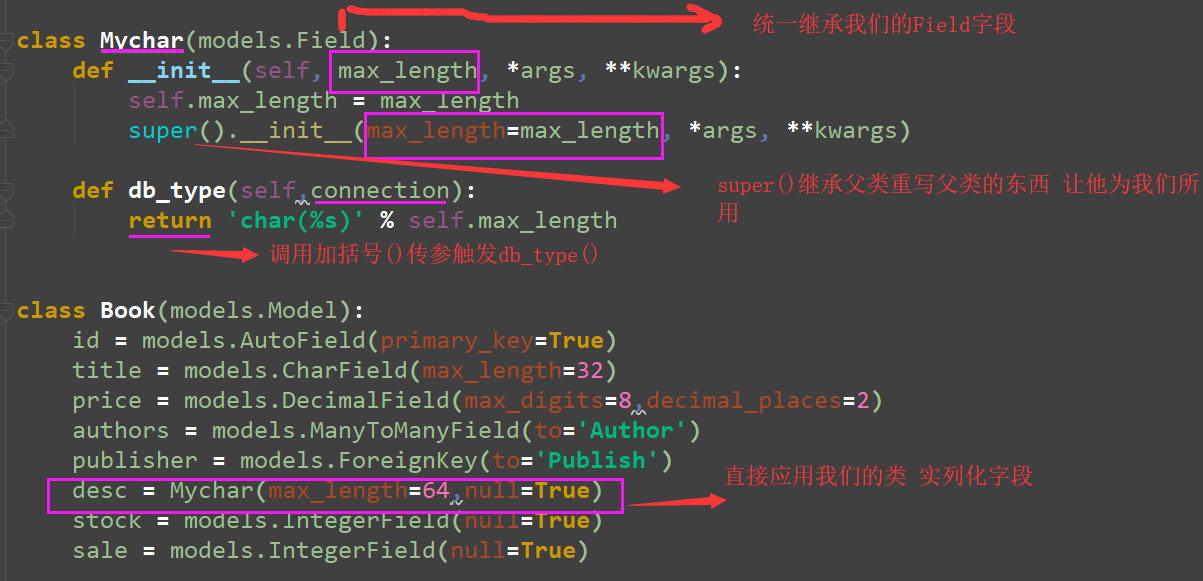一、Django框架的常用字段
Django ORM 常用字段和参数
常用字段
常用字段 AutoField int自增列,必须填入参数 primary_key=True。当model中如果没有自增列,则自动会创建一个列名为id的列。 IntegerField 一个整数类型,范围在 -2147483648 to 2147483647。(一般不用它来存手机号(位数也不够),直接用字符串存,) CharField 字符类型,必须提供max_length参数, max_length表示字符长度。 这里需要知道的是Django中的CharField对应的MySQL数据库中的varchar类型,没有设置对应char类型的字段,但是Django允许我们自定义新的字段,下面我来自定义对应于数据库的char类型
日期类型
DateField 日期字段,日期格式 YYYY-MM-DD,相当于Python中的datetime.date()实例。 DateTimeField 日期时间字段,格式 YYYY-MM-DD HH:MM[:ss[.uuuuuu]][TZ],相当于Python中的datetime.datetime()实例。
字段合集(争取记忆)

AutoField(Field) - int自增列,必须填入参数 primary_key=True BigAutoField(AutoField) - bigint自增列,必须填入参数 primary_key=True 注:当model中如果没有自增列,则自动会创建一个列名为id的列 from django.db import models class UserInfo(models.Model): # 自动创建一个列名为id的且为自增的整数列 username = models.CharField(max_length=32) class Group(models.Model): # 自定义自增列 nid = models.AutoField(primary_key=True) name = models.CharField(max_length=32) SmallIntegerField(IntegerField): - 小整数 -32768 ~ 32767 PositiveSmallIntegerField(PositiveIntegerRelDbTypeMixin, IntegerField) - 正小整数 0 ~ 32767 IntegerField(Field) - 整数列(有符号的) -2147483648 ~ 2147483647 PositiveIntegerField(PositiveIntegerRelDbTypeMixin, IntegerField) - 正整数 0 ~ 2147483647 BigIntegerField(IntegerField): - 长整型(有符号的) -9223372036854775808 ~ 9223372036854775807 BooleanField(Field) - 布尔值类型 NullBooleanField(Field): - 可以为空的布尔值 CharField(Field) - 字符类型 - 必须提供max_length参数, max_length表示字符长度 TextField(Field) - 文本类型 EmailField(CharField): - 字符串类型,Django Admin以及ModelForm中提供验证机制 IPAddressField(Field) - 字符串类型,Django Admin以及ModelForm中提供验证 IPV4 机制 GenericIPAddressField(Field) - 字符串类型,Django Admin以及ModelForm中提供验证 Ipv4和Ipv6 - 参数: protocol,用于指定Ipv4或Ipv6, 'both',"ipv4","ipv6" unpack_ipv4, 如果指定为True,则输入::ffff:192.0.2.1时候,可解析为192.0.2.1,开启此功能,需要protocol="both" URLField(CharField) - 字符串类型,Django Admin以及ModelForm中提供验证 URL SlugField(CharField) - 字符串类型,Django Admin以及ModelForm中提供验证支持 字母、数字、下划线、连接符(减号) CommaSeparatedIntegerField(CharField) - 字符串类型,格式必须为逗号分割的数字 UUIDField(Field) - 字符串类型,Django Admin以及ModelForm中提供对UUID格式的验证 FilePathField(Field) - 字符串,Django Admin以及ModelForm中提供读取文件夹下文件的功能 - 参数: path, 文件夹路径 match=None, 正则匹配 recursive=False, 递归下面的文件夹 allow_files=True, 允许文件 allow_folders=False, 允许文件夹 FileField(Field) - 字符串,路径保存在数据库,文件上传到指定目录 - 参数: upload_to = "" 上传文件的保存路径 storage = None 存储组件,默认django.core.files.storage.FileSystemStorage ImageField(FileField) - 字符串,路径保存在数据库,文件上传到指定目录 - 参数: upload_to = "" 上传文件的保存路径 storage = None 存储组件,默认django.core.files.storage.FileSystemStorage width_field=None, 上传图片的高度保存的数据库字段名(字符串) height_field=None 上传图片的宽度保存的数据库字段名(字符串) DateTimeField(DateField) - 日期+时间格式 YYYY-MM-DD HH:MM[:ss[.uuuuuu]][TZ] DateField(DateTimeCheckMixin, Field) - 日期格式 YYYY-MM-DD TimeField(DateTimeCheckMixin, Field) - 时间格式 HH:MM[:ss[.uuuuuu]] DurationField(Field) - 长整数,时间间隔,数据库中按照bigint存储,ORM中获取的值为datetime.timedelta类型 FloatField(Field) - 浮点型 DecimalField(Field) - 10进制小数 - 参数: max_digits,小数总长度 decimal_places,小数位长度 BinaryField(Field) - 二进制类型 字段合集
对应关系

对应关系: 'AutoField': 'integer AUTO_INCREMENT', 'BigAutoField': 'bigint AUTO_INCREMENT', 'BinaryField': 'longblob', 'BooleanField': 'bool', 'CharField': 'varchar(%(max_length)s)', 'CommaSeparatedIntegerField': 'varchar(%(max_length)s)', 'DateField': 'date', 'DateTimeField': 'datetime', 'DecimalField': 'numeric(%(max_digits)s, %(decimal_places)s)', 'DurationField': 'bigint', 'FileField': 'varchar(%(max_length)s)', 'FilePathField': 'varchar(%(max_length)s)', 'FloatField': 'double precision', 'IntegerField': 'integer', 'BigIntegerField': 'bigint', 'IPAddressField': 'char(15)', 'GenericIPAddressField': 'char(39)', 'NullBooleanField': 'bool', 'OneToOneField': 'integer', 'PositiveIntegerField': 'integer UNSIGNED', 'PositiveSmallIntegerField': 'smallint UNSIGNED', 'SlugField': 'varchar(%(max_length)s)', 'SmallIntegerField': 'smallint', 'TextField': 'longtext', 'TimeField': 'time', 'UUIDField': 'char(32)', ORM字段与MySQL字段对应关系
二、自定义char 字段 因为Django 框架 是没有char 类型字段 CharField() 字段对应到数据库就是varchar 字段
但是他给我们提供了一种另外一自定义char 的接口
class Mychar(models.Field): def __init__(self, max_length, *args, **kwargs): self.max_length = max_length super().__init__(max_length=max_length, *args, **kwargs) def db_type(self,connection): return 'char(%s)' % self.max_length class Book(models.Model): id = models.AutoField(primary_key=True) title = models.CharField(max_length=32) price = models.DecimalField(max_digits=8,decimal_places=2) authors = models.ManyToManyField(to='Author') publisher = models.ForeignKey(to='Publish') desc = Mychar(max_length=64,null=True) stock = models.IntegerField(null=True) sale = models.IntegerField(null=True)

字段参数
字段参数 null 用于表示某个字段可以为空。 unique 如果设置为unique=True 则该字段在此表中必须是唯一的 。 db_index 如果db_index=True 则代表着为此字段设置索引。 default 为该字段设置默认值。 DateField和DateTimeField auto_now_add 配置auto_now_add=True,创建数据记录的时候会把当前时间添加到数据库。 auto_now 配置上auto_now=True,每次更新数据记录的时候会更新该字段。
关系型字段
ForeignKey 外键类型在ORM中用来表示外键关联关系,一般把ForeignKey字段设置在 '一对多'中'多'的一方。 ForeignKey可以和其他表做关联关系同时也可以和自身做关联关系。 字段参数 to 设置要关联的表 to_field 设置要关联的表的字段 on_delete 当删除关联表中的数据时,当前表与其关联的行的行为。 models.CASCADE 删除关联数据,与之关联也删除 db_constraint 是否在数据库中创建外键约束,默认为True。
其余字段
复制代码
models.DO_NOTHING
删除关联数据,引发错误IntegrityError
models.PROTECT
删除关联数据,引发错误ProtectedError
models.SET_NULL
删除关联数据,与之关联的值设置为null(前提FK字段需要设置为可空)
models.SET_DEFAULT
删除关联数据,与之关联的值设置为默认值(前提FK字段需要设置默认值)
models.SET
删除关联数据,
a. 与之关联的值设置为指定值,设置:models.SET(值)
b. 与之关联的值设置为可执行对象的返回值,设置:models.SET(可执行对象)
OneToOneField
OneToOneField
一对一字段。
通常一对一字段用来扩展已有字段。(通俗的说就是一个人的所有信息不是放在一张表里面的,简单的信息一张表,隐私的信息另一张表,之间通过一对一外键关联)
字段参数
to
设置要关联的表。
to_field
设置要关联的字段。
on_delete
当删除关联表中的数据时,当前表与其关联的行的行为。(参考上面的例子)
三、数据库的查询优化
1.only 与defer 默认是惰性查询 只有我们要结果才会向数据库去执行
only
# 数据库查询优化 # # defer与only # res = models.Author.objects.all().values('name') # 这样虽然能拿到对象的name属性值,但是已经是queryset里面套字典的格式,我现在想拿到queryset里面放的还是一个个的对象,并且这这些对象“只有”name属性,其他属性也能拿,但是会重新查询数据库,类似于for循环N次走N次数据库查询 # res = models.Author.objects.all().only('name') # 一旦指导了only就不要取对象没有的属性值了 # # defer与only刚好相反,取不包括括号内的其他属性值 res = models.Book.objects.only('title') # <QuerySet [<Book: 三国演义>, <Book: 花花>, <Book: 西游>, <Book: 红楼梦>, # <Book: 西厢记>, <Book: 西>, <Book: 小小>]> print(res) for r in res: # print(r.title) # (0.000) SELECT `ap01_book`.`id`, `ap01_book`.`title` FROM `ap01_book` LIMIT 21; args=() # <QuerySet [<Book: 三国演义>, <Book: 花花>, <Book: 西游>, <Book: 红楼梦>, <Book: 西厢记>, <Book: 西>, <Book: 小小>]> # (0.000) SELECT `ap01_book`.`id`, `ap01_book`.`title` FROM `ap01_book`; args=() # 三国演义 # 花花 # 西游 # 红楼梦 # 西厢记 # 西 # 小小 # 第一次那总的走了一次诗句库 print(r.price) # 199.00 # (0.000) SELECT VERSION(); args=None # (0.001) SELECT `ap01_book`.`id`, `ap01_book`.`price` FROM `ap01_book` WHERE `ap01_book`.`id` = 6; args=(6,) # (0.001) SELECT `ap01_book`.`id`, `ap01_book`.`price` FROM `ap01_book` WHERE `ap01_book`.`id` = 7; args=(7,) # 77.66 # (0.001) SELECT `ap01_book`.`id`, `ap01_book`.`price` FROM `ap01_book` WHERE `ap01_book`.`id` = 8; args=(8,) # 669.00 # (0.000) SELECT `ap01_book`.`id`, `ap01_book`.`price` FROM `ap01_book` WHERE `ap01_book`.`id` = 9; args=(9,) # 9999.00 # 69.00 # 88.00 # (0.000) SELECT `ap01_book`.`id`, `ap01_book`.`price` FROM `ap01_book` WHERE `ap01_book`.`id` = 10; args=(10,) # (0.000) SELECT `ap01_book`.`id`, `ap01_book`.`price` FROM `ap01_book` WHERE `ap01_book`.`id` = 11; args=(11,) # (0.001) SELECT `ap01_book`.`id`, `ap01_book`.`price` FROM `ap01_book` WHERE `ap01_book`.`id` = 14; args=(14,) # 345.00 # 小结:这李除了第一天数据库的查询 另外向数据库请求了7次 # 总结:only会将('title') 会将参数要查询的结果放到自己的容器对象中可以理解为缓存在一个容易 下次再来访问就不再需要访问数据库来了
defer
res = models.Book.objects.defer('title') for r in res: # print(r.title) # (0.001) SELECT `ap01_book`.`id`, `ap01_book`.`price`, `ap01_book`.`publisher_id`, `ap01_book`.`desc`, `ap01_book`.`stock`, `ap01_book`.`sale` FROM `ap01_book`; args=() # (0.001) SELECT VERSION(); args=None # (0.000) SELECT `ap01_book`.`id`, `ap01_book`.`title` FROM `ap01_book` WHERE `ap01_book`.`id` = 6; args=(6,) # 三国演义 # (0.000) SELECT `ap01_book`.`id`, `ap01_book`.`title` FROM `ap01_book` WHERE `ap01_book`.`id` = 7; args=(7,) # (0.000) SELECT `ap01_book`.`id`, `ap01_book`.`title` FROM `ap01_book` WHERE `ap01_book`.`id` = 8; args=(8,) # 花花 # (0.001) SELECT `ap01_book`.`id`, `ap01_book`.`title` FROM `ap01_book` WHERE `ap01_book`.`id` = 9; args=(9,) # 西游 # 红楼梦 # (0.001) SELECT `ap01_book`.`id`, `ap01_book`.`title` FROM `ap01_book` WHERE `ap01_book`.`id` = 10; args=(10,) # (0.001) SELECT `ap01_book`.`id`, `ap01_book`.`title` FROM `ap01_book` WHERE `ap01_book`.`id` = 11; args=(11,) # 西厢记 # 西 # (0.000) SELECT `ap01_book`.`id`, `ap01_book`.`title` FROM `ap01_book` WHERE `ap01_book`.`id` = 14; args=(14,) # 小小 print(r.price) # 199.00 # (0.000) SELECT @@SQL_AUTO_IS_NULL; args=None # 77.66 # 669.00 # 9999.00 # 69.00 # 88.00 # 345.00 # (0.001) SELECT `ap01_book`.`id`, `ap01_book`.`price`, `ap01_book`.`publisher_id`, `ap01_book`.`desc`, `ap01_book`.`stock`, `ap01_book`.`sale` FROM `ap01_book`; args=()
only和defer 两个相反的用法 》》》》分情况使用
only 频繁要用其中一条主数据的术后我们可以用only()将他查出来 下次再进行访问的时候的 我们可以不用再访问数据库减缓数据的压力,提高查询效率
defer 取反
2.select_releated与prefect_releated
select_releated
# select_related与prefetch_related # select_related帮你直接连表操作 查询数据 括号内只能放外键字段 # res = models.Book.objects.all().select_related('publish') res = models.Book.objects.all().select_related('publisher') for r in res: print(r.publisher.name) # (0.002) SELECT `ap01_book`.`id`, `ap01_book`.`title`, `ap01_book`.`price`, `ap01_book`.`publisher_id`, `ap01_book`.`desc`, `ap01_book`.`stock`, `ap01_book`.`sale`, `ap01_publish`.`id`, `ap01_publish`.`name`, `ap01_publish`.`publish_date` FROM `ap01_book` INNER JOIN `ap01_publish` ON (`ap01_book`.`publisher_id` = `ap01_publish`.`id`); args=() # 东方出版社 # 东方出版社 # 东方出版社 # 南方出版社 # 北方出版社 # 北方出版社 # 北方出版社 # 小结: """ # select_related:会将括号内外键字段所关联的那张表 直接全部拿过来(可以一次性拿多张表)跟当前表拼接操作 # 从而降低你跨表查询 数据库的压力 # # 注意select_related括号只能放外键字段(一对一和一对多) # res = models.Book.objects.all().select_related('外键字段1__外键字段2__外键字段3__外键字段4') # """
prefect_releated
""" 不主动连表操作(但是内部给你的感觉像是连表操作了) 而是将book表中的publish全部拿出来 在取publish表中将id对应的所有的数据取出 res = models.Book.objects.prefetch_related('publish') 括号内有几个外键字段 就会走几次数据库查询操作 """
· 四、事务
4.1事务的四大特性:ACID
原子性
一致性
隔离性
永久性
4.1 如何开启
with 上下管理
开启事务 提交commit() 回滚rollback()是之前数据库的三个重要的标识
·
# 需要导入模块 from django.db import transaction # 开启事务 with transaction.atomic(): """ 再该with 下的操作数据库 都是属于操作同一事务 """ models.Book.objects.create() models.Publish.objects.create() # 要么同时成功要么 要么都哦不成功
modles.Product .objects.filter(id=1).update(kucun=F('kucun)-100) 》》》 —100
modles.Product.objects.filter(id=1).update(maichu=F('maichu')+100) 》》》 +100
print('出了 代码块 事务就结束') 只要出来with 事务结束
